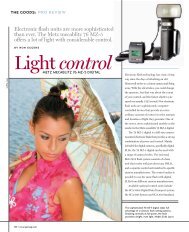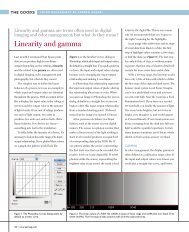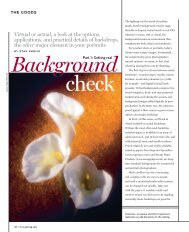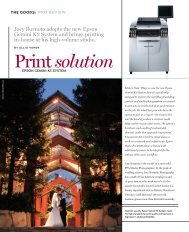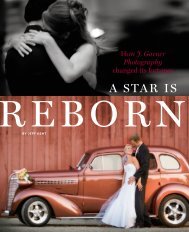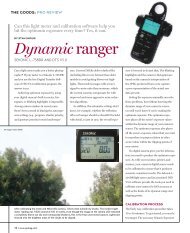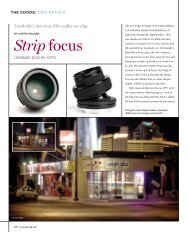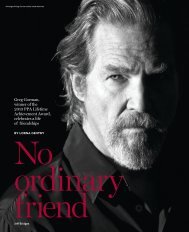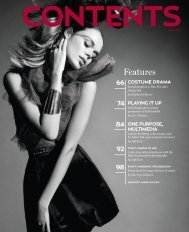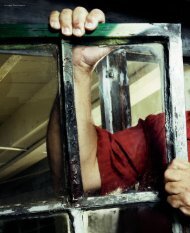Zeiss Distagon T* 35mm f/1.4 ZF.2 Lens - Professional ...
Zeiss Distagon T* 35mm f/1.4 ZF.2 Lens - Professional ...
Zeiss Distagon T* 35mm f/1.4 ZF.2 Lens - Professional ...
Create successful ePaper yourself
Turn your PDF publications into a flip-book with our unique Google optimized e-Paper software.
THE GOODS: PRO REVIEW<br />
<strong>Zeiss</strong> not only lives up to expectations, it exceeds them.<br />
BY STAN SHOLIK<br />
As good as it gets<br />
ZEISS DISTAGON <strong>T*</strong> 35MM F/<strong>1.4</strong> <strong>ZF.2</strong> LENS<br />
For five years, Carl <strong>Zeiss</strong> has produced single<br />
focal length, manual focus lenses for camera<br />
bodies that accept Nikon, Canon, Sony, K-<br />
mount, and M-42 screw-mount lenses. These<br />
lenses are highly regarded by landscape, closeup<br />
and portrait still photographers, for both<br />
film and digital cameras. Videographers<br />
have also become a major market.<br />
The latest in the series is the <strong>Zeiss</strong> <strong>Distagon</strong><br />
<strong>T*</strong> <strong>35mm</strong> f/<strong>1.4</strong>, presently available with<br />
Nikon and Canon mounts. I tested the<br />
Nikon <strong>ZF.2</strong> model.<br />
<strong>Zeiss</strong> incorporates an improved <strong>T*</strong> antireflection<br />
coating and a nine-blade aperture<br />
for a nearly circular diaphragm. If you’ve<br />
ever wondered about the pleasing bokeh<br />
effect, you’ll instantly know it when you<br />
view images shot at f/<strong>1.4</strong> with this lens.<br />
The silky smooth focusing ring on the<br />
<strong>35mm</strong> f/<strong>1.4</strong> rotates through about 150 degrees<br />
from minimum focusing distance to infinity,<br />
for extremely accurate focusing. At an aper ture<br />
of f/<strong>1.4</strong>, the image is four times brighter than<br />
one shot with an f/2.8 lens, making focus ing<br />
easy, even with the viewfinder screens in modern<br />
digital SLR cameras. The focusing ring stops<br />
when you turn it to infinity or the minimum<br />
focusing distance, so you always know where<br />
those points are. These attributes are what<br />
endear <strong>Zeiss</strong> lenses to videographers.<br />
The aperture ring includes half-stop<br />
detents that click firmly into place between<br />
the marked aperture settings. The extensive<br />
use of metal in the lens construction gives it<br />
the look, feel and weight of classic Nikkors.<br />
The <strong>35mm</strong> f/<strong>1.4</strong> is a monster compared to<br />
my <strong>35mm</strong> f/<strong>1.4</strong> Nikkor. The <strong>Zeiss</strong> weighs<br />
more than twice as much, is twice the<br />
length, and requires 72mm filters rather<br />
than the Nikkor’s 52mm filters. Having<br />
tested other <strong>Zeiss</strong> lenses, I wasn’t surprised<br />
to find the <strong>35mm</strong> f/<strong>1.4</strong> superior to my old<br />
Nikkor <strong>35mm</strong> f/<strong>1.4</strong>, but it’s surprising how<br />
far more superior it is.<br />
Even at maximum aperture, the <strong>Zeiss</strong><br />
shows superb sharpness in the center of the<br />
lens. Sharpness falls off somewhat to the<br />
edges of the frame, if you ever place the<br />
subject near the edge of the frame when<br />
shooting wide open. By f/2, sharpness is<br />
excellent everywhere. There’s a hint of barrel<br />
distortion at f/<strong>1.4</strong> on a full-frame camera,<br />
but that too disappears by f/2. Distortion is<br />
non-existent on a DX-format camera.<br />
Vignetting is quite apparent at f/<strong>1.4</strong> on a<br />
full-frame camera and requires stopping<br />
down two stops to eliminate it. I’m a little<br />
surprised by this, given the size of the lens,<br />
but I’m a fan of vignetting, so it doesn’t<br />
All images ©Stan Sholik<br />
The lens handles bold colors equally as well as<br />
subtle ones. Even though the lens is manual<br />
focus, the viewfinder is so bright that it is easy<br />
to focus even on a banner blowing in the wind.<br />
The stitching on the foreground flag is tack sharp.<br />
70 • www.ppmag.com
other me. Vignetting was less apparent<br />
with my old Nikkor, the only facet in which<br />
the Nikkor beat out the <strong>Zeiss</strong>.<br />
If the <strong>Zeiss</strong> lens has a weakness it’s the<br />
way it controls chromatic aberration near<br />
the edges of the image with a full-frame<br />
digital camera. Chromatic aberration was<br />
invisible on film, but more obvious than I<br />
expected in images from a D3X. It’s easily<br />
corrected in post, but I expected better.<br />
Fast prime lenses open new possibilities<br />
for all photographers. The low-light capability<br />
enables photojournalists to capture images<br />
in difficult available-light situations. The<br />
beautiful quality of out-of-focus backgrounds<br />
and the strong vignetting make the lens<br />
useful for portrait and fashion shooters. The<br />
astounding overall image quality when<br />
stopped down by two stops, where f/2.8<br />
zoom lenses suffer the worst image quality,<br />
renders the lens appropriate for landscape<br />
photographers as well. And even sports<br />
photographers, if they can get close enough<br />
to the action, would benefit from the ability<br />
to increase shutter speed by two EV and<br />
eliminate distracting backgrounds. The<br />
<strong>Zeiss</strong> <strong>35mm</strong> f/<strong>1.4</strong> <strong>ZF.2</strong> lens for Nikon and<br />
its Canon equivalent are valuable additions<br />
to the <strong>Zeiss</strong> line of ultra-fast lenses, joining<br />
the 50mm f/<strong>1.4</strong> and the 85mm f/<strong>1.4</strong>.<br />
MSRP for the <strong>35mm</strong> f/<strong>1.4</strong> <strong>ZF.2</strong> lens is<br />
$2,395, with a street price of about $1,850.<br />
See lenses.zeiss.com for more information<br />
about the <strong>35mm</strong> and the other <strong>Zeiss</strong> lenses<br />
for Nikon, Canon, K-mount and M42<br />
screw-mount bodies. n<br />
Stan Sholik is a commercial/advertising<br />
photographer in Santa Ana, Ca., specializing<br />
in still life and macro photography. His fifth<br />
book, “Nik HDR Efex Pro” (Wiley Publishing)<br />
will be published next month. Find more<br />
images at ppmag.com/current_issue.<br />
Ultra-fast lenses aren’t only for shooting at maxi -<br />
mum aperture in low light. Here I stopped the lens<br />
down to increase the depth of field and increased<br />
the ISO so I could hold the heavy lens steady in<br />
the light at dusk. I was amazed that the lens was<br />
able to accurately render all of the subtle tonal<br />
variations I saw in the failing light at sunset.<br />
<strong>ZF.2</strong> OVERVIEW<br />
The original series of <strong>Zeiss</strong> lenses for Nikon<br />
was designated ZF. ZF lenses function with<br />
all film and digital SLRs that are designed<br />
for Nikon lenses, from the original Nikon F<br />
to the latest D3 models, as well as Kodak<br />
and Fuji digital SLRs. Not only are the<br />
classic Nikon metering prong (which can be<br />
easily removed if desired), auto-indexing<br />
(AI) ring and tiny secondary aperture scale<br />
included, but both the aperture and<br />
focusing rings rotate in the same direction<br />
as Nikon’s original lenses. Even the<br />
markings are engraved and filled with white<br />
paint—no silk-screening here.<br />
While the ZF series is still available, the<br />
newer <strong>ZF.2</strong> lenses are enhanced versions of<br />
the ZF lenses. They feature an electronic<br />
interface (CPU). This CPU enables the <strong>ZF.2</strong><br />
lenses to support all-important operating<br />
modes such as shutter priority, aperture<br />
priority and programmed auto exposure or<br />
manual exposure settings even on non-AIcompatible<br />
camera housings. No longer is it<br />
necessary to set the parameters in the<br />
camera menu, as the lenses now transmit<br />
standard data such as focal length, speed<br />
and the aperture setting to the camera. This<br />
data can then be viewed in the EXIF data of<br />
each picture.<br />
The metering prong is not available on<br />
the <strong>ZF.2</strong> lenses, so you cannot use light<br />
metering on older cameras (F, F2, Nikkormat,<br />
etc.). The <strong>ZF.2</strong> lenses have a mechanical<br />
lock on the aperture ring to lock it at the<br />
lowest setting and prevent unintentional<br />
adjustment while taking pictures. They<br />
even have the engraved number<br />
representing the smallest aperture filled<br />
with orange paint, just as the Nikkor AI-P<br />
lenses did.<br />
While the mechanicals may seem retro,<br />
the <strong>35mm</strong> f/<strong>1.4</strong> is thoroughly modern.<br />
Technicians at the Carl <strong>Zeiss</strong> factory in<br />
Oberkochen, Germany, create the optical<br />
and mechanical specifications along with<br />
quality targets for the ZF lenses. Production<br />
is done at the Cosina factory in Japan under<br />
the watchful eye of Carl <strong>Zeiss</strong> employees in<br />
charge of quality assurance.<br />
September 2011 • <strong>Professional</strong> Photographer • 71



